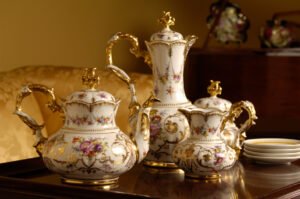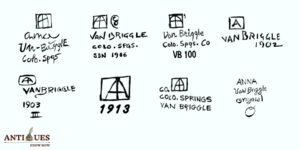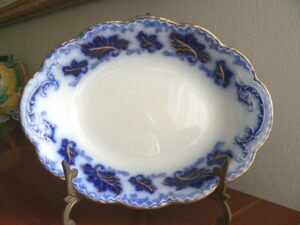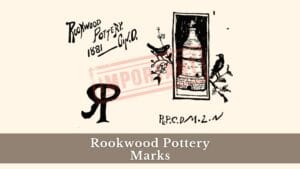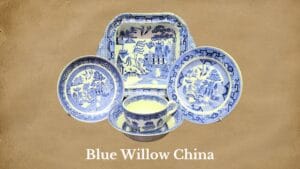Edelstein porcelain is popular among collectors for its solid gold trims, hand-painted floral designs, and most of all, its iconic branded German make. And the best way to ensure that a piece is from German Edelstein Bavaria is by its marks!
The unique Edelstein Bavaria porcelain marks can help you easily track its age, identify its pattern, and avoid fakes. In this guide, you’ll learn about all Edelstein Bavaria trademarks, codes, and location marks. There are Edelstein valuation tips at the end!
Brief History of Edelstein Porcelain Company

Edelstein Bavaria (Edelstein Porzellanfabrik) is a popular Kups-based German company founded in 1919. The fine china company is known for its kaolin porcelain production with gilded floral patterns and figurine motifs.
The Edelstein Bavaria Company went through the following vital historical events:
- 1919: Julius Edelstein & Isidor Grünebaum purchased the Oberfränkische Porzellanfabrik, a porcelain painting unit founded by Friedrich Ohnemüller & Emil Speiser, for over 280,000 marks.
- 1923: Julius modernized the company as a stock corporation and renamed it to the ‘Porzellanfabrik Edelstein GmbH (Gesellschaft mit beschränkter Haftung i.e a company with limited liability.)
- 1926: The German manufacturer suffered in a loan deal by the Steingutfabrik and lost most of its shares. Later, leading German earthenware brand Colditz AG seized Edelstein’s factory and changed its name to the ‘Porzellanfabrik J. Edelstein AG.’
- 1941: After Julius was murdered, the Porzellanfabrik J. Edelstein AG factory continued making classical Baroque, Empire, and Rococo-style porcelain pottery under the able leadership of Fritz Greiner, a former NSDAP member.
Identifying Real Edelstein Bavaria Porcelain Marks & Codes
Some collectors identify REAL Edelstein porcelain with its unique solid-gold accents and trims. But the rest of the archaic-features-fanatics naturally turn toward the etched ‘Bavaria’ marks to verify the porcelain ware’s age, maker, and location.
These ‘Bavaria’ marks aren’t new; archaeologists have traced old china-marked Bavaria porcelain ware back to the early 1800s. However, Edelstein used various markings on his ceramics to make his company stand out.
Edelstein Bavaria Porcelain features four types of unique marks that can help you identify the piece easily.
1. Edelstein Trademarks
The ‘Bavaria’ porcelain logo was commonly used by all the local artists and German porcelain companies in the 1800s. So, when Edelstein started his business in the 1920s, he added his brand name and a few other design elements.
For instance, the early 1920s Bavaria porcelain marks portray a 2-D, doodled headdress on top, while the 1942 mark had a stamped year date. I’ve hand-drawn all these marks for your reference:
| Edelstein Bavaria Trademarks | Trademark Years | Estimated Age |
 | (1924 – 1933) | 90 – 100 years |
 | 1942 | Around 80 years |
 | 1929 – 1972 | 51 – 94 years |
However, if your porcelain ware has no clear mark, you can still date it by observing its era-specific features as follows:
- Early 1920s – 1940s: You can identify these early hotel-line porcelain pieces by their floral, multicolor designs, gold handles, and wavy or round edges. Popular collectibles include hotel-line plates, bowls, trays & other serving ware.
- 1940 – 1970: Edelstein transitioned to modern and military designs with abstract Maria Theresia, Agate, Rose, Edelstein Gold, Platinum, Iris, Sunflower, and Butterfly patterns.
- 1970 & Onwards: Inspired by local, minimal design movements, these new Edelstein pieces had bold, pop-color stripe, circle, and square designs with plain, rounded edges and self-print borders.
2. Number Stamps (Pattern Codes)
On many Edelstein Bavaria items, you’ll see some numbers marked along with the trademarks on the underside, as shown below. These numbers are either stamped in with black ink or gilded.


The five-digit number stamp on Edelstein China is the original pattern code assigned by the factory. It is associated with the particular design applied to the piece. Later, the factory started marking the pattern names, too (see below).
The lower one- to three-digit number is the foreman ID code marked by a foreman or factory supervisor to indicate that the piece has passed quality control. This mark was made to ensure a smooth workflow within the factory.
I’ve created a handy chart for common pattern codes and their corresponding names using real items that I’ve appraised over the years:
| Pattern Code | Edelstein Bavaria Pattern Name |
| 21613 | Florence |
| 16703 | Maria Theresia Moss Rose |
| 18551 | Maria Theresia Lily of the Valley |
| 22123 | Maria Theresia Primrose |
| 22497 | Flamingo |
| 22803 | Spring Floral |
| 20067 | Aurora |
| 18187 | Modesto |
| 20735 | Handarbeit |
Unfortunately, there are no records or information database of earlier Edelstein pattern codes (3 or 4-digit codes) or the meaning of quality control marks.
So, if you have an Edelstein Bavaria piece with any other visible pattern number, share your pictures in our Antiques Know How Forum, and I’ll help you identify it!
3. Edelstein Pattern or Series Marks
Edelstein company started marking the pattern names along with the pattern codes to make pattern identification easier for workers as well as sellers.
The early 1920 – 1930s Edelstein pieces had a stylized ‘Maria Theresia’ mark, named after the only female ruler of the Hapsburg empire. This Edelstein Bavaria Maria Theresia porcelain is known for its intricate, pastel floral designs and hand-brushed gold trims.
The new post-1930s porcelain pieces have stamped pattern names as shown below:
| Edelstein Bavaria Series Mark | Edelstein Bavaria Series Name | Identifying Features |
 | Maria Theresia | Multicolored floral pattern with hand-brushed gold trims |
 | Florence | Pink and blue Rosette & flower pattern with pale green leaves & vines |
 | Spring Floral | A sparse border pattern with pink tulips & yellow /purple flowers |
 | Alameda | Pink & yellow orchid-like design with raised, grass motifs |
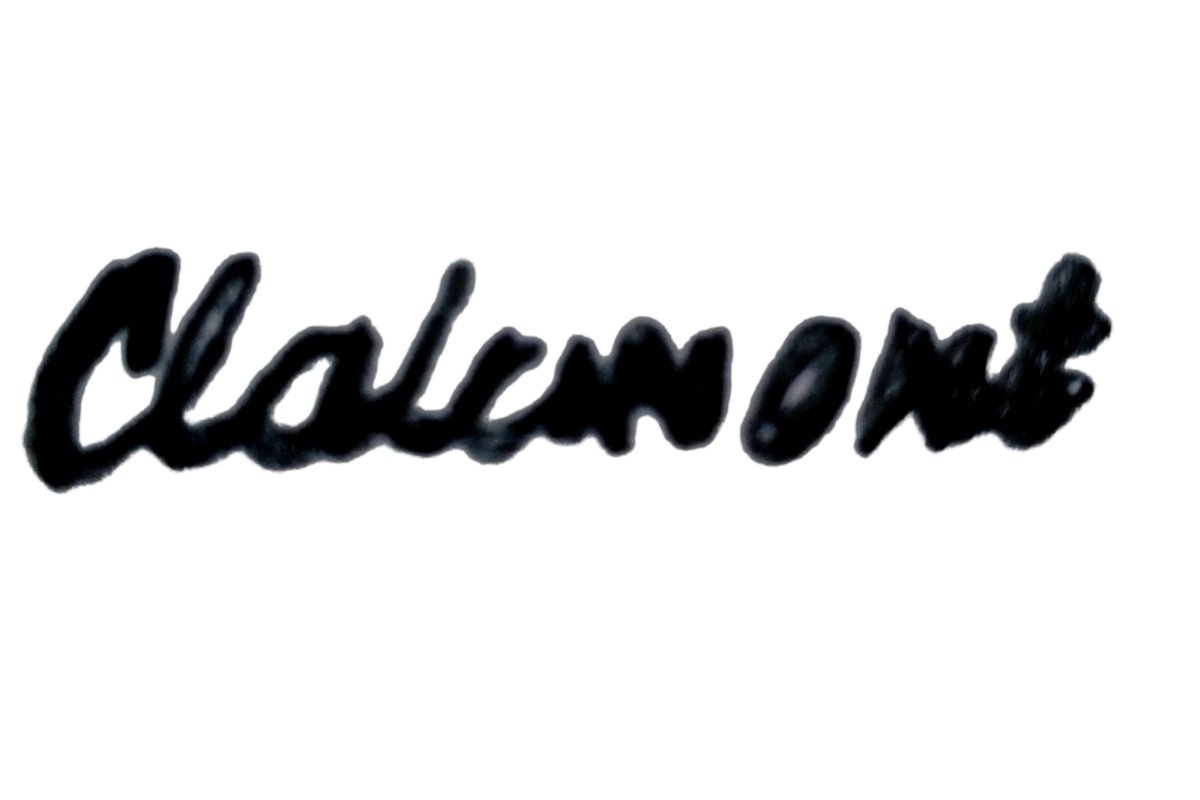 | Clair Mont | Border pattern with pink & orange flowers & olive leaves |
4. Location Marks
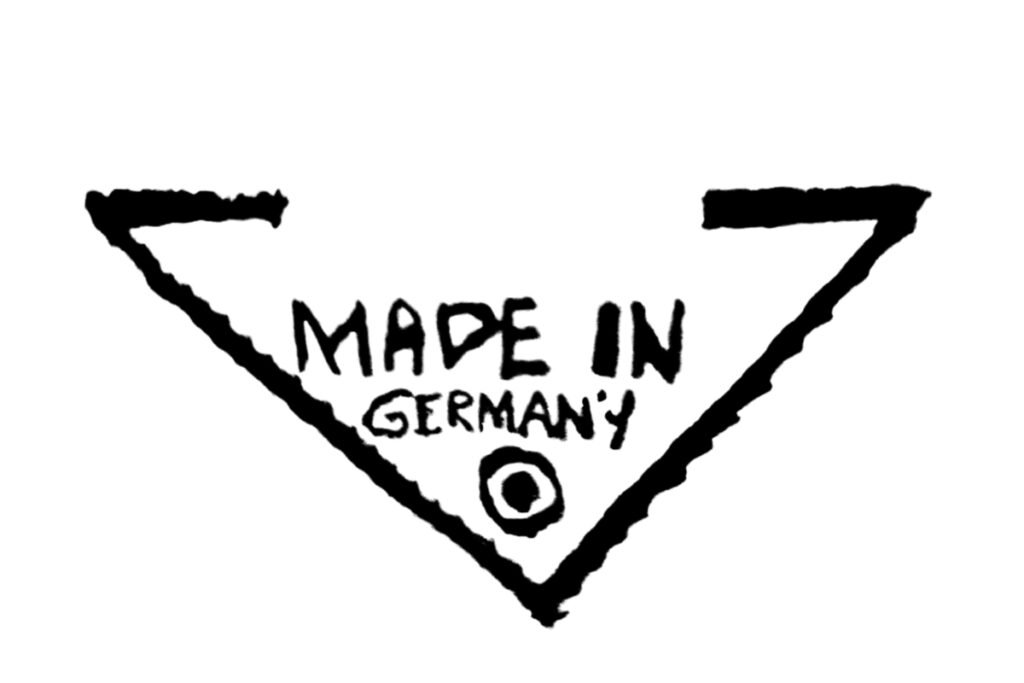

Another mark that confirms the authenticity of Germany-based Edelstein porcelainware is the ‘Made in Germany’ mark at the base. The earlier Edelstein pieces have a simple mark, while the later ones have the “V” shaped mark shown above.
Besides, the real Edelstein Bavaria has etched brown, black, or gold ink location marks. They may still have gray or faded spots in some areas, especially at the corners and joints of the alphabet.
If you see any other stamp, such as ‘Made in China’ or ‘Made in Japan’ on your pottery, then it’s not Edelstein.
Identify Fake Edelstein Porcelain Marks
Although Edelstein Bavaria Porcelainware has unique, identifiable marks, not all the marks are real! Some makers try to pass on fake pottery with fake multi-colored and plain Edelstein marks, as shown below!


These bogus or reproduced Edelstein Bavaria porcelain also has other features to easily spot it:
- Fake Edelstein marks often have misspelled brand names, like “Edelstem Bavaria” or “Edeliteen Bavaria.”
- You’ll find bold red, blue, or yellow marks and names, unlike the real, black, or gilded ones. Besides, the fake marks are flat (stamped), while the real marks have raised die edges.
- In contrast to real golden-rimmed porcelain, the fake pieces with Edelstein marks likely have silver, brass, or platinum rims.
- Location or import marks from ‘China,’ ‘Japan,’ or ‘Asia’
- Fake Edelstein pieces may feature a strange pattern that was never really produced by the Edelstein factory.
Finding the Value of Edelstein Bavaria Porcelain

The common collectible Edelstein china in good condition is worth around $50 – $600, but rare pieces can also have a high value of up to $1,000! Check the following recent auction and sale details, referenced from authentic sites, like eBay, Etsy, and 1stDibs, for a better sense of real-time values:
- A 26-piece Florence pattern Edelstein Bavaria set with slight chips and defects was sold for $395 on eBay.
- A set of two 1970s Edelstein Bavaria porcelain vases fetched $600 on 1stDibs.
- A large Edelstein Bavaria China Serving Set is available at $950 on eBay!
- An Edelstein Bavaria Maria Theresia Victorian coffee pot sold for $325 on Rubylane.
Generally, the value of old Edelstein porcelain depends on the type and size of the piece, whether it’s tableware or dinnerware. For example, Edelstein plates sell for $5 – $50, with over $80 for full sets, while the bowls and creamers are worth $5 – $120. Large Edelstein platters, vases, and pots are valued at $200 – $300!
Smaller sets of Edelstein porcelainware, like a 6-piece Edelstein Maria Theresia set, will be worth around $100 – $250 or more, but a larger complete set with 10 or 12 pieces, comprising creamers, butter dishes, plates, bowls, and platters, can fetch up to $1,000.
Identifying old Edelstein Bavaria pottery becomes a lot easier when you can recognize authentic marks and numbers. You can verify your Edelstein ceramics’ marks with the ones shown in this guide or share them directly with me for identification assistance.
If you need help with identifying other branded antique porcelain, such as Sevres, Royal Vienna, Capodimonte, or Meissen porcelain, I have shared dedicated detailed value and ID guides for each of them!
Note: This article is intended for informational, educational, and entertainment purposes only. Some images are illustrative and may not represent actual brands, products, or related entities. All trademarks, product names, brand logos, packaging, and other intellectual property referenced remain the exclusive property of their respective owners. Any brand mentions or references are provided solely for descriptive and educational context and do not imply any formal or commercial association.



